Only six days have passed since the release of Descent of Dragons, but the Hearthstone balance team has already announced plans for a nerf targeted at Shaman. While the speed of this response is unprecedented, we believe it’s absolutely necessary to ensure the long-term vibrancy of Hearthstone’s ladder system.
Blizzard, We Have A Problem
If you’ve queued ladder over the last few days, you’ve no doubt been terrorized by the strongest deck in the game: Galakrond Shaman. A quick look at the statistics should be enough to convince you of the list’s power. Galakrond Shaman currently boasts a winrate over 61% across all ranks. This trend is replicated across individual ranks, too:
- Legend - 57.84% (sole occupant of Tier 1)
- Rank 1 - 54.59%
- Rank 2 - 54.36% (sole occupant of Tier 1)
- Rank 3 - 55.89% (sole occupant of Tier 1)
- Rank 4 - 58.01% (sole occupant of Tier 1)
- Rank 5 - 60.59% (sole occupant of Tier 1)
Galakrond Shaman wins against everything. Literally. This may well be the most astounding matchup spread we’ve ever seen. Not only does Galakrond Shaman win, it dominates. Let’s take a look at Galakrond Shaman’s winrates against the ten most popular decks on Ladder:
- Galakrond Quest Shaman - 55%
- Highlander Mage - 59.5%
- Secret Highlander Hunter - 62%
- Holy Wrath Paladin - 42.7%
- Deathrattle Rogue - 58.6%
- Galakrond Rogue - 60.9%
- Pirate Warrior - 65%
- Quest Druid - 72.2%
- Aggro Combo Priest - 56.4%
- Control Warrior - 72.3%
Most of these matchups are downright lopsided, an insult to the ideal of balance.
Truth be told, there are perhaps two “counters” in the metagame, but only one is a true counter: Holy Wrath Paladin. Holy Wrath beats Shaman in about 43% of cases (over a sample of 6,200 games between five and Legend), but because it loses to almost everything else, we still wouldn’t call it viable. Outside of Holy Wrath Paladin, Quest Hunter is the only deck in the metagame to even come close, breaking even against Galakrond Shaman with a winrate of 50% over 4,100 games between five and Legend.
Terrorizing Ladder
Galakrond Shaman is too powerful, which means, as it usually does, that Galakrond Shaman is too popular. At rank 1, Galakrond Shaman represents an astounding 46.5% of the meta. That’s frankly obscene, and things only get slightly better elsewhere.
- Legend - 24.02%
- Rank 1 - 46.55%
- Rank 2 - 38.96%
- Rank 3 - 31.92%
- Rank 4 - 23.85%
- Rank 5 - 14.72%
- Rank 6 - 25.34%
- Rank 7 - 19.88%
- Rank 8 - 17.28%
- Rank 9 - 15.09%
- Rank 10 - 11.72%
What’s truly surprising is how well-represented Galakrond Shaman has become lower on the ladder. Most dominant decks emerge at Legend, then filter down the ranks over the course of a few weeks as word gets out. Galakrond Shaman has already bucked this trend, instantaneously becoming a force at ranks 6 and below. We rarely see such saturation at lower ranks so early.
Above rank four, every match is a Shaman mirror. At least it feels that way, so ubiquitous is the cry of “Double the power, double the storm!” Nothing could be more stultifying, but it’s downright insulting after the Evolve meta.
Galakrond Shaman’s overwhelming power also means fewer players are venturing out on the Standard ladder. We’ve already observed a plateau in player activity (and remember, it’s only six days after the release of Descent of Dragons). No doubt many of us have been driven to Wild, or back to Battlegrounds. This is likely the worst possible way to have kicked off Descent of Dragons, but here we are, mired again in Shamanstone. It’s clear beyond a shadow of a doubt that Galakrond Shaman is suppressing what could be a diverse meta.
Why Shaman Puts The S In S-Tier
Galakrond Shaman is the best tempo deck in the meta, capable of pumping out terrifying boards turn after turn. But it’s also the best control deck in the meta, in large part because it’s blessed by a keyword generally reserved for Warrior and Hunter: Rush. In fact, Galakrond Shaman proves that Rush is the most powerful keyword, outside of Charge, in the game.
Under normal circumstances, minions must wait, and players must be patient. Summoning sickness is the fatal flaw by which most minions in Hearthstone are marked. Shaman doesn’t have to worry about that anymore. Thanks to the power of Invoke, most of Galakrond Shaman’s key cards circumvent their fatal flaw and make an immediate impact on the board state; these are no longer potential threats, but active ones. Add [Hearthstone Card (Faceless Corrupter) Not Found] to the mix and Shaman becomes uniquely proactive in its game plan. With an endless stream of rushing tokens, Galakrond Shaman can control the board state more efficiently than any other list, setting up its big power plays in Dragon's Pack and Galakrond.
Shaman’s Invoke ability is oppressive because it acts as a near-universal answer to any board state. No wonder Galakrond Shaman is suppressing what could be some of the most powerful decks in the game, including Pirate Warrior, which received an incredible new tool in Ancharrr, and Deathrattle Rogue.
Repealing The Invoke Tax
Perhaps even more important, however, is how Shaman’s Invoke ability balances out the inherent weaknesses of the neutral Invoke cards, Devoted Maniac and Shield of Galakrond. On their face, both minions are under-statted for their cost. This tempo loss comes in exchange for a benefit in the future: a fully-powered Galakrond. But because Shaman’s Invoke summons Rush minions, the full benefits of Invoking aren’t deferred to the future; they’re felt immediately, in the present. In reality, Invoke is a tempo gain for Shaman, rather than a loss. Tempo is king in Hearthstone, and initiative is queen. It’s always been this way, and no one does it better than Galakrond Shaman.
"Invoke Twice"
To top things off, Shaman is the only EVIL class to receive a double-Invoker, Corrupt Elementalist. Why Blizzard was so generous we’ll never know.
Invoking Galakrond usually comes at a cost, not only in mana, but also in cards. Normally, it’s a one-to-one ratio - one card equals one Invocation, which makes Invoking your Galakrond a relatively slow process. Only in Shaman is this sensible formula forsaken, because Corrupt Elementalist Invokes twice with a single card.
Thus Shaman is able to Invoke more efficiently than any other class, ensuring that Galakrond is fully-Invoked on curve more often than not. And despite the obvious power increase brought by Descent of Dragons, two 8/8 minions are still extremely difficult to answer on turn 7, especially when they can clear the board with Rush and are accompanied by a 5-attack weapon.
The Best Payoff In The Game
Dragon's Pack adds insult to injury. Outside of Galakrond himself, Dragon’s Pack is the payoff for Invoking, a card that summons two 5/6 spirit wolves with Taunt if you’ve Invoked twice. That’s a ridiculous tempo play in its own right - 10/12 in stats, with Taunt, as early as turn 5. But thanks to Corrupt Elementalist, which satisfies the condition on Dragon’s Pack by itself, playing the spell on curve (if you have the Coin) or on turn 6 is easy.
Dragon’s Pack alone ends the game against many tempo decks, and, since it can come down so early, it’s hard for control decks to clear, too, evading the wrath of Handlock’s Crazed Netherwing, Highlander Mage’s Flamestrike (and Reno the Relicologist) and Galakrond Priest’s Mass Hysteria.
No other EVIL class was given an Invoke payoff card this powerful, at least in terms of bare tempo. Warrior’s payoff card, Scion of Ruin, while an excellent tempo card in its own right, only summons 9/6 in stats (and usually comes down later than turn 5). Rogue’s Umbral Skulker (which adds three Coins to your hand) adds +3/3 to a Questing Adventurer or +6/6 to an Edwin VanCleef. Veiled Worshipper (Warlock) and Fate Weaver (Priest) are tempo-neutral, if not slight losses in today’s Standard metagame. In comparison, 10/12 in stats is monstrous.
Shaman’s Galakrond package is overturned, plain and simple. Thankfully, Blizzard has recognized this fact and plans to act swiftly. We don’t want to see Galakrond Shaman obliterated, though some players surely do. What we want is a vibrant, diverse meta in which numerous strategies, including but not limited to Galakrond Shaman, can succeed on their own terms. As it stands, Galakrond Shaman is both jack and master of all trades.
Honorable Mention: Faceless Corruptor
We know Shaman is getting a nerf, because Blizzard told us so, but if we had to guess, we’d expect changes to come for Faceless Corruptor, too. This shouldn’t come as much of a surprise, since the card is obviously overturned. Corruptor summons 10/8 in stats, with Rush, as early as turn 5. That’s obscene, and far too good for most players to pass up.
No doubt Blizzard still has flashbacks from the days of Bonemare, when massive tempo swings off the back of a neutral minion were far too common. Like Bonemare back in the day, Corruptor has made its way into almost every metadeck, at least the ones that care about tempo. It’s currently the most-played card in the game, appearing in 52.8% of decks. That sort of representation is likely to make Blizzard uncomfortable.
This week’s Meta Report was a bit different, but we thought it was necessary to address the elephant in the room. As far as fixes go, increasing Corrupt Elementalist’s mana cost could be a start, but it might not be enough. Adding an Overload effect is an interesting option, because it would delay Dragon’s Pack at least one turn. Or Blizzard could go nuclear, fundamentally altering the package’s flavor by removing Rush from the equation.
What do you think? How will Blizzard nerf Shaman? What decks will rise to the top of the meta if the Shaman nerfs are effective? Let us know in the comments!


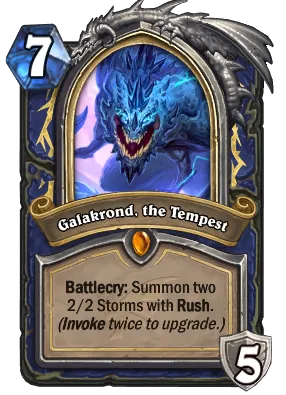
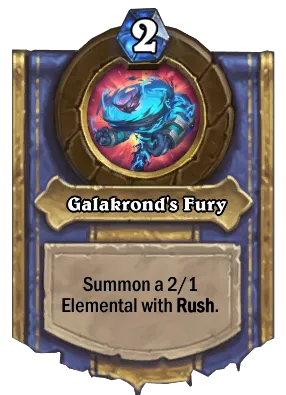
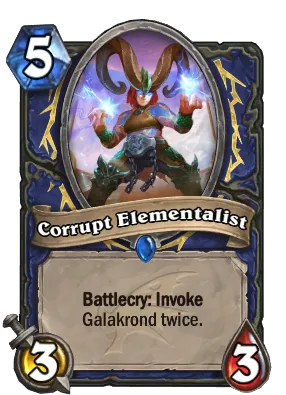
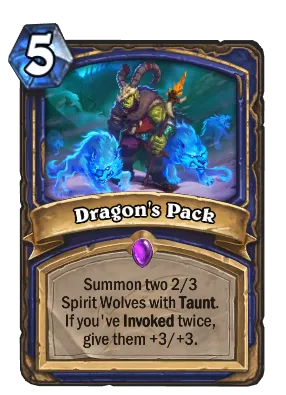
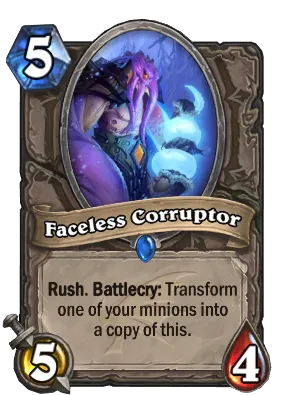





![All The Great Dark Beyond Card Reveals for October 12 - Day 2 [Finished]](dark-beyond-reveals-day-2-thumb.webp)
Comments
About the four 4/4's vs two 8/8's I think that getting four 4/4's would be easier to deal with. It is the same amount of stats, and you do get to spread it out more, but the minions are also taking damage faster. With an 8/8, you can kill a 6/6 in one hit and you still have an 8/2, but with two 4/4's, you would have to kill both of them to get rid of a 6/6 and you are left with nothing. Plus, you can kill multiple 4/4's with a single AOE, but with a pair of 8/8's you need multiple single target removal spells. Furthermore, it takes up more space on the board, which does matter when the deck wants to swarm a lot.
fair enough. I guess it's a matter of what matchup it's supposed to be good against. 4 4/4s is weaker against control, but stronger against midrange, 8/8s are the other way round.
Just want to add one more thing kind of on the flip side from my rant below. Playing Galakrond Shaman feels amazing. Generating minions and lackeys and value and just continually nonstop refilling and going AT your opponent relentlessly feels amazing. Feels really powerful and satisfying. Feels equally horrible to the opponent of course. Closest thing from memory might be Deathstalker Rexxar at his worst.
But if all the classes had that power level and could throw and take punches and go toe to toe with powerful decks like that...well I don't know how well that can be balanced but seems like that's kinda what they're going for with this expansion. Make Shaman powerful and fun. Great. But makes all 8 other classes powerful and fun too! High power levels are a blast but it's gotta be balanced.
It's just weird. Like...do the people making cards for different classes talk to each other? How does Shaman get Corrupted Elementalist and Invocation of Frost (also a very good card) while Warlock gets Dragonblight Cultist and Fiendish Rites??? Warlock's invoke cards are shit. Fiendish Rites is ok if you've got a somewhat wide board but garbage if not. Dragonblight Cultist is a piece of shit. Oh you spent 3 mana for a 5/1 and two 1/1s? Cute. Allow me to ping that 5/1 easily as if it never existed. Meanwhile....Corrupted Elementalist??? Are you fucking joking? Do these people talk to each other?
Not to mention Warlock Galakrond's battlecry is extremely meh. You played your Galakrond and summoned two 8/8s with rush? Well let me retaliate with my....Void Terror and...Witchwood Imp...and Fellstalker and Witchwood Piper. Fear me.
The other classes' invokes: get a lackey, get a random Priest card, summon two 1/1s (off of shit tempo cards), deal 3 with your face
Shaman: deal 2 free damage on board immediately...twice...or four times
Oh and then there's Dragon's Pack. Yeah just a little cherry on top. Oh and infinite Shudderwock from Faceless Corrupter/Barista.
Oh and that whole sliiiightly oppressive quest they have that doubles their battlecries. Yeah that was a good idea.
Oh and Mogu/Mutate.
Oh and Evolve. Oh that's gone? Hm guess I'm not over the PTSD. It's like it's right here in my living room happening all over again. Bringing that back was awesome. Then laying Galakrond Shaman on us right afterward. Nice one-two punch there.
Like just.....fucking get your SHIT together and keep this game within the bounds of sanity so that we can have fun playing a variety of decks in a diverse meta with all these cool cards you've given us. Is that really too much to ask?? Is that REALLY too much??? Cuz that is ALL that I am fucking ASKING FOR!!!!
I haven't stopped giving of my money, my time, or...honestly...my love for this game. I was and still am stoked for DoD. It has a lot of potential. They really need to take charge and balance the game frequently and fine tune it to get it to where we all deserve it to be! Including the devs.
Of course some fuckface in a suit who doesn't care about any of this is the one pushing the faceless, heartless, entirely profit focused agenda of Blizzard's that is ever at odds with perfecting the game...what could be the greatest game in the world by far if they strove for greatness and sacrificed a few pinched pennies to get there. I'm sure the devs have to squeeze blood from those stones just to do as much as they have. I just hope somehow the seas will part and they can just give the game the treatment that it needs. Make Hearthstone truly great Blizzard!
/rant
to be fair, Galakrond Warlock is not nearly as bad as you make it out to be. The Invokers, while not that strong, are good enough to be played and Veiled Worshipper carries the deck to the point where even a Galakrond Handlock has been created (that performs slightly better than the regular version) just because of how storng that card is.
Galakrond itself isn't even weak ,because by the time you play him you usually want to finish off the opponent, whiich is what the Claw is for. The Demons are just an added bonus and you usually get at least one minion that's a 5/5 or above, which is good enough for the final pressure. He's not a real powerplay as he is just your final tool to close out the game (especially with the follow-up Kronx).
I'd argue that Warlock is the second best class to use Galakrond right now, even if only for the amazing synergy with Grim Rally and Sea Giant.
First of all: Amazing meta report guys.
What i think Blizzard should do:
Make Galakronds elementals 1/1 with rush or 2/1 without it.
Corrupt Elementalist - 5 mana and nerf stats to 1/1. Mana increase only if elementals keep rush.
Dragon's Pack - Mana increase for 7.
Faceless Corruptor - keep it at 5 mana and change stats to 3/2 with rush.
Special mention:
Mogu Fleshshaper - is not the problem at all. Blizzard must change the entire evolve idea and keep what almost every player always says: evolve the card at actual mana cost and not at basis mana cost.
What i think Blizzard WILL do:
Corrupt Elementalist - Mana increase.
Dragon's Pack - Mana increase.
Faceless Corruptor - Mana increase.
Special mention:
Totally agree with this one.
It was pleasure to read this article. Keep up good work.
I ve seen how blizz balancing and, i think, here is only 2 options - completly destroy sham (unlikely) and underwhelming nerfs and sham will be still tier 1 but 1 or 2 decks will be his counters and blizz will be fine with it.
Anyway, expansion launch was ruined, i don t know how they will fix player base in standart now
Predicted that shaman would have been top tier before, and also the faceless nerf.
Now I think that shaman will still tier1 even after nerfs!
I see quite a few suggested nerfs that would completely kill Shaman altogether mentioned here. Surely that can't be the point.
To 'fix' Galakrond, the Tempest I'd suggest just 2 nerfs:
This would also balance the Corrupt Elementalist as it will have much lower impact when played.
Faceless Corruptor should only be nerfed if the data shows it's a problem in multiple classes. It's not just Shaman that benefits here and shouldn't be included in a nerf that tries to rebalance Shaman's power level.
Finally, Mogu Fleshshaper is just a dumb card in my opinion and shouldn't exist in the first place. They could consider Hall of Faming it with the next rotation or just nerf it into oblivion, by changing its cost to 12 or having the cost reduction only look at Friendly minions.
I liked your sugestions, but I think the problem is the rush keycard, is too powerfull for a class like shaman, I played 3 games with to just complete my daily quest and I just needed to play on curve to win
100% agree, this is the most one-terrible-deck meta ever (although it used to say always) the complete dominance of one deck wasn't so far the case. We saw a lot of times rock-paper-scissor meta, but now it's just rock, a lot of scissors and no paper at all.
The most sad thing is, there are plenty of good and fun decks, but they are in the shade of shaman super deck.
Really don't know what the design team though if they printed mentioned cards all together. If even a single cart itself is good enough to be in competitive play.
Great article. It’s such a waste of an expansion start, and completely unbelievable how they managed to give shamans more overpowered battlecry minions
Great meta report on shamanstone. I like how blizzard kept the most OP Galakrond shaman cards until the last reveal date only for us to see nothing but those few cards from launch.
Probable nerf contenders and some opinions:
Corrupt Elementalist - Mana increase. Blizzard don't wave the nerf stick around on effects that much and I don't see them doing so now. Expecting it to be 7 mana, since at 6 it still seems too good not to include.
Dragon's Pack - Mana increase for the same reason above. Probably at 6. Without good invoke cards, this is dead weight in the hand
Galakrond - I'm pretty sure this would not get hit. But if it does then its probably going to affect the size of the raging elementals from the battlecry. Two 6/6 with rush, still playable. But with a nerf to elemetalist, it might still be "fair" for two 8/8 rush as a reward for playing Galakrond shaman.
Faceless Corruptor - I'm probably the minority here but I really don't see this card as an issue even if it was included in every deck. Its condition requires a minion on board to play on curve and two 5/4 on turn 5-6 isn't really that bad considering that the opponent can do the same. But the reasoning with Bonemare resonates, so if this gets nerfed at all, it would probably be bumped to 6 mana
Special mention:
Mogu Fleshshaper - Don't know why this card exist for a class with evolve options, or why it has rush. But it has dodged every nerf swings since SoU so let us hope and pray he gets the hit this time.
Its condition requires you to have ANYTHING on board or Lackey in hand. Card is busted and shouldve never been printed.
The card is definitely busted. But being a neutral card means that I get to play a similarly busted card as do my opponent. And that's why I think team5 would probably wait for more data before nerfing this to oblivion.
The problem with galakrond shaman is that most of the cards listed is basically only available to shaman. Had Corrupt Elementalist been a neutral card the calls for it to be put down would probably not been unanimous
The card is nowhere near the levels of power demonstrated by the cards listed above and past cards like Corridor Creeper and Bonemare. I would argue that its at the cliff edge of busted. Probably as intended.
This way of thinking about neutral cards isn't quite right. When Baku the Mooneater was the king of the standard meta, did you see a lot of Odd Priests? And when Grim Patron was around, were there a lot of non-Warrior classes taking advantage of that super powerful neutral card?
Many neutral cards synergize with specific strategies, and class differences mean that simply being a neutral card doesn't mean you fit into decks for every class. A card like Faceless Corruptor will always be unusually strong in decks that can generate junk minions (EVIL classes with lackeys, hyper aggro archetypes, Paladin and Shaman with hero powers, etc.), while control decks (whose AOE tools typically do about 3 damage that this point) will struggle to clear it.
A nerf on its stats is entirely appropriate to ensure it doesn't get to be both a strong tool for board-centric mirrors and a ton of free tempo against control decks.
Correct. It is not near, it is better. Free 5/4 with rush is better than free 5/5 or pesudo 4/4 with charge+taunt if you have board. And It allows you to not be punished by your mistakes. Behind on board? Faceless Corruptor. Enemy left a 1/1 on board instead of full clear? Faceless Corruptor. Enemy DID clear your board? Faceless Corruptor+1/1. In aggro match up you can lose a board, then play Faceless Corruptor and instantly win it. The game of HS becomes the game of "Who Drew Faceless Corruptor First". If not for the absolute madness of Gala Shaman everone would be hating on this card instead. As they should.
We can agree to differ I guess. For my own part I've never been able to point out this card being a problem when I lose my match and certainly not at turn 5-6. Similarly, I've never been tempted to keep the card in my mulligan unless I got a 1 drop and/or 3 drop in hand.
For what its worth, this is not the case with Corridor Creeper when it was played in every deck. It was a hard mulligan for this card in every matchup and that was why it was nerfed to the ground.
Smells like full dust refund ^^